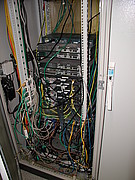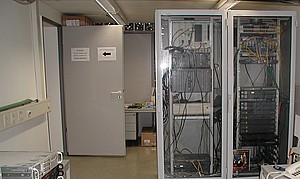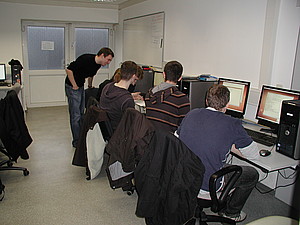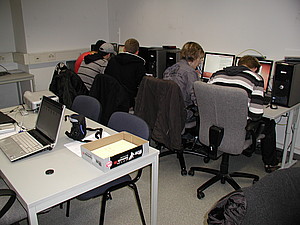Network laboratory
Network laboratory
Research and teaching in networking technology require a multifaceted networking laboratory as fundamental infrastructure. Thus the chair of computer networking technology group built and operates two network laboratories. The technology used in computer networks does not operate isolated but always in distributed systems. Changes to single nodes always have an impact on the whole network, which is the reason why we require a networking infrastructure that provides technologies as diverse as possible, allowing us to demonstrate mechanics and protocols to our students as well as embedding special techniques and research projects into the network. For research purposes the network laboratory is the „real-life“ environment to our research projects. The network provides the required services and interfaces.
For a later port of our research projects to production networks an analysis of interactions with existing technology is essential. It is important to represent the whole network or rather the whole communication chain. Also analysis or simulation driven research activities require validation of theoretical results by measurements and experiments in network setups.


In cases that require simulation capacities exceeding those that our networking laboratories can provide, our chair of computer networking technology group partakes in the German research network German-Lab and the worldwide research network Planet-Lab.
Researching the practicability of new concepts by prototyping implementations in a experimental setups contributes considerably by providing those concepts with newfound aspects and questions. Further, our teaching concept includes usage of the network laboratory for exercises and practicals to demonstrate concepts introduced in lectures.
Compared to other analysis-driven disciplines, students often have a harder time grasping the architecture and mechanism driven communication technology due to abstract concepts being the dominant methodology. By actually using modern network technology components, students are enabled to make the connection between taught concepts and applying those concepts in practice. Exercises and practicals allow students to broaden the theoretical knowledge gained in lectures by building network configurations on their own.


We aim to integrate most relevant networking protocols and techniques in the network laboratory with the least equipment possible. The plans for the current development stage already include a set of technologies:
Public wide area networking technology, using ATM. A WAN switch with terminals and management have been donated to the chair by Siemens.
Protocols used in LAN and the corporate field. Mixed environments with ATM- and IP-based networks are state of the art. We want to represent the most common networking protocols with our core infrastructure.
Last mile connection techniques and integration of ISDN. With this we want to integrate the future end customer technique ADSL and new IP telephony into our composite infrastructure, to allow reproduction of a complete transmission chain to the customer.
Applications and network services. Analysis and implementation of higher networking protocols require a number of different terminals, which allow for a high variety in configurations. This allows tests and demonstrations of application interoperability on the network.
Measurement technology. To analyze and evaluate planned network technology, we reuire network protocol analyzers. We already acquired a smaller network analyzer, which at this point can only measure at on point of the network.
For tests and analysis of protocols in realistic testbeds we contribute nodes to to the research networks German-Lab and Planetlab.
